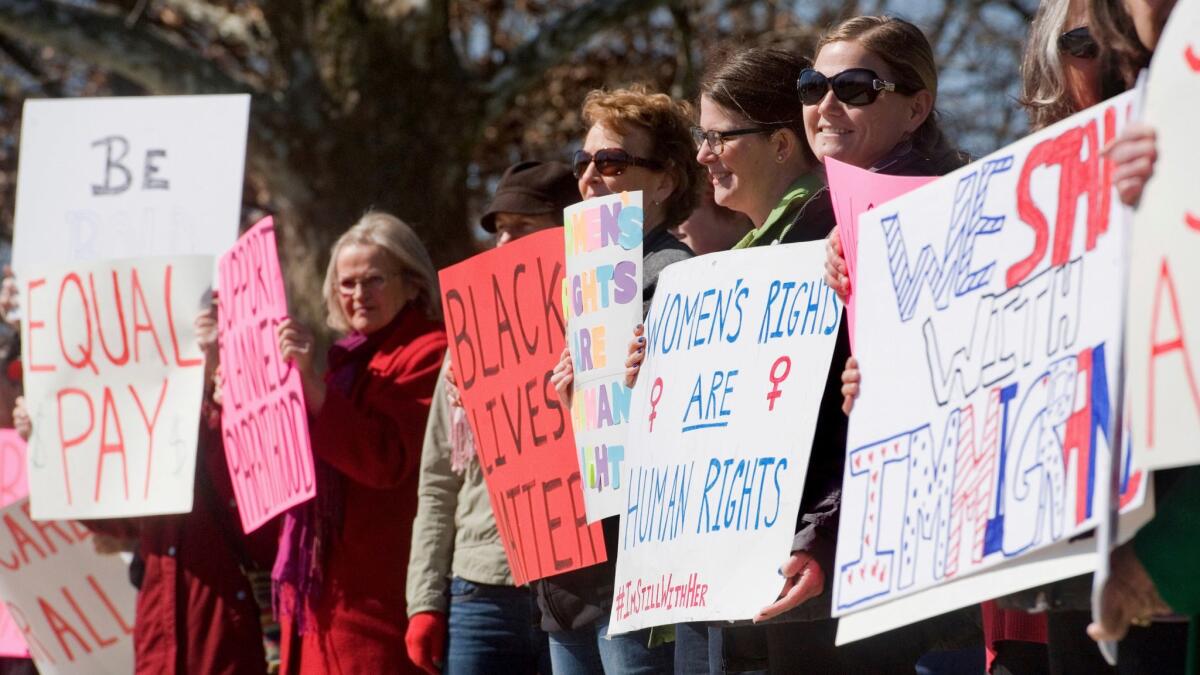Young American women are poorer than their moms and grandmas, and more likely to commit suicide

Young American women are poorer than their mothers and grandmothers were when they were young, more likely to commit suicide and be shut out of high-paying tech jobs — an overall demise in well-being since the baby boom generation.
Those are the findings in a new report by the Population Reference Bureau, a nonprofit that looks at population and other development issues. It found that social and structural barriers continue to obstruct the advancement of female members of Generation X and millennials.
For experts working on women’s issues, the report’s conclusions came as no surprise.
“We have been pushed back, there’s no question,” said Terry O’Neill, president of the National Organization for Women. “Younger women are really feeling the effects of ... a 30-year march to dismantle government agencies, to dismantle government protections, all in the name of free markets.”
We have been pushed back, there’s no question.
— Terry O’Neill, president, National Organization for Women
The report used 14 measures to assess “well-being” — such as earning capacity, education and health — to calculate the magnitude of the change between the status of young women today relative to women in their mothers’ and grandmothers’ generations when they were the same age.
“We expected to see that there would be certain subgroups of women that would be doing much worse than others, but we were surprised to find that women overall were doing worse than the previous generation,” said Mark Mather, associate vice president of U.S. programs at Population Reference Bureau and co-author of the report.
Members of the Baby Boom generation, who were born between 1946 and 1964, saw their well-being increase by 66% over their World War II counterparts, but the improvements did not continue for Generation X women, born between 1965 and 1981. They experienced a 2% gain in well-being relative to the Baby Boomers, while millennial women, born between 1982 and 2002, experienced a 1% decline in well-being, according to the report.
Improvements in young women’s economic security began to stagnate during the mid-1990s, and their struggles have continued into the millennial generation, particularly among women without college degrees, the report said.
In addition to health, education and earning capacity, the Population Reference Bureau considered other measures of well-being, including teen birth and maternal mortality rates, the prevalence of cigarette smoking and incarceration rate.
The eroding social safety net, violence against women, unequal pay — the Bureau of Labor Statistics put the median weekly earnings of full-time working men at $895 in 2015 compared to $726 for women—were other factors hindering the overall well-being of young women, according to the report.
African American women, Latinas, American Indian and Alaska native women were most susceptible to bad outcomes, compared to their white and Asian American counterparts, Mather said.
The report found that the proportion of women aged 30 to 34 years old living in poverty had increased to around 17% for the millennial generation, up from 12% for Generation X females. While Generation X women comprised 1 in 4 workers in high-paying STEM occupations, the statistic dropped to 1 in 5 for millennial females, according to the report.
Such trends are being targeted by the White House, which hosted a women’s empowerment panel in March. In February, President Trump signed a pair of bills into law aimed at recruiting more women for the fields of science, technology, engineering and math. But such efforts take time to take root.
“If you don’t have a college degree today it is very difficult to make enough to support yourself and your family,” said Mather. “And for people in low-wage jobs it’s not just that they don’t have enough earnings, they often don’t have very good benefits.”
If they have young children it’s often hard for them to find affordable childcare, and transportation costs are high, Mather said.
An analysis by the Center for American Progress, a Washington-based independent nonpartisan policy institute, found that the average annual cost of childcare for an infant younger than 12 months old is $18,000 a year for a 45-hour work week. That’s “more than the entire annual income of a parent who is earning the federal minimum wage for those hours,” said Sunny Frothingham, the organization’s senior researcher for women’s economic policy. “And the majority of minimum wage earners are in that 16- to 34-year-old age range.”
Shilpa Phadke, the institute’s senior director of Women’s Initiative, noted, “If we look at this particular generation of millennials, they came of age during the recession, they had to search for jobs in a really tough labor market, and were looking to higher education as student debt was skyrocketing.”
The Population Reference Bureau report also found that millennial women faced higher rates of maternal mortality than their mothers and grandmothers and were also more likely to commit suicide. In addition, the proportion of women imprisoned had increased 10-fold between the World War II generation and the millennial generation.
The report also identified several positive trends for young women, including a decline in the high school dropout rate, and an increase in the number of women with at least a bachelor’s degree. Disparity in earnings and business ownership has also diminished for women since World War II, and teen births are at historic lows. Successive generations have seen more women elected to Congress and state legislatures.
But the positive trends failed to outweigh the negative, Mather said.
“Today we’re just seeing much less progress across the board, and as a result it didn’t take a whole lot to drag down the overall index of well-being so that we saw this negative result for millennial women,” he said.
For more on global development news, see our Global Development Watch page, and follow me @AMSimmons1 on Twitter
ALSO
Better ties between the U.S. and Cuba? Miami’s Cubans are divided
More to Read
Sign up for Essential California
The most important California stories and recommendations in your inbox every morning.
You may occasionally receive promotional content from the Los Angeles Times.











